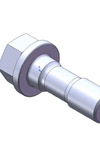Fixing the fixings
 A leading race engine manufacturer ran into fastener problems recently when out of the blue they suffered two separate incidents of flywheel bolt failure, each on a different specification of engine, during the same test. One failure had occurred on a standard specification engine and the other on one which had been given an increase in torque of 30%.The manufacturer found themselves with a difficult engineering problem to solve and one which needed fixing very quickly.
A leading race engine manufacturer ran into fastener problems recently when out of the blue they suffered two separate incidents of flywheel bolt failure, each on a different specification of engine, during the same test. One failure had occurred on a standard specification engine and the other on one which had been given an increase in torque of 30%.The manufacturer found themselves with a difficult engineering problem to solve and one which needed fixing very quickly.
Receiving no support from the fastener manufacturer the engine manufacturer turned to independent mechanical design consultant Tom Sharp, for a solution.The first stage, as with any failure analysis, was to physically analyse the failed flywheel bolts which were bespoke hex head bolts made from a precipitation hardening stainless steel.The standard engine had only failed a few of its eight bolts and it was immediately apparent that in each case, failure had occurred on the third thread away from the bolt head, which in this case was the first active thread. However, upon examining a non-failed bolt from the same engine it became apparent that the threads had stretched; this was visually obvious with a mechanical pitch gauge.Subsequent investigation confirmed that the manufacturer had been following poor advice and re-using the flywheel bolts; this test had been their fourth application. Under certain circumstances that would be acceptable but test calculations proved that the bolts were yielding in the threads upon tightening.The solution for the standard engine was simply to use new bolts in the short term and to re-use them only once, but in future, re-designed bolts will be made which will stretch in the shank rather than the threads, and which will be tightened to around 75% of yield strength.The increased torque engine had suffered an entirely different failure, as this was the engine’s first ever use and all eight bolts had failed catastrophically. Close examination showed evidence of fatigue failure (the engine had been run in) and failure was attributed to chronic overload. Whether this was due to the increase in torque or torsional vibration loading remains uncertain, as time pressure prevented further investigation on this front.The designer’s proposal was to modify the crankshaft to increase the thread size of the bolts, and to produce a new bolt from multi-phase alloy; a Nickel-Cobalt-Chromium-Molybdenum alloy which has a yield strength of 2000 MPa against 1200 MPa of a precipitation hardening stainless.The replacement bolt was designed with a location diameter under the head and a reduced shank such that the majority of the bolt’s stretching took place in the shank. They also ensured stress in the threads was at or below the level of stress in the shank. After production, tightening trials were carried out to ensure that the bolt would consistently achieve a given pre-load. A settling torque followed by an angle technique was used and the tightening trials repeated the results achieved by the designer/manufacturer to within a few percentage points.The speed of the project was such that within three weeks of TSMD’s Tom Sharp receiving the failed bolts, the new bolts were fitted and running successfully.